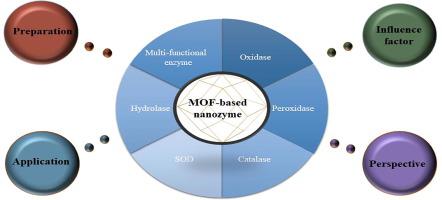Coordination Chemistry Reviews ( IF 20.6 ) Pub Date : 2021-09-15 , DOI: 10.1016/j.ccr.2021.214216 Xiang Huang 1 , Songtao Zhang 1 , Yijian Tang 1 , Xinyu Zhang 1 , Yang Bai 1 , Huan Pang 1

|
Nanozymes bridge the fields of inorganic nanomaterials and biology and have attracted wide attention. Nanozymes have the catalytic capabilities of inorganic materials at the nanoscale, and, thus, the potential to replace natural enzymes. As porous organic–inorganic coordination materials, metal–organic frameworks (MOFs) have a large number of active sites and can mimic the properties of natural enzymes. Therefore, MOF-based nanozymes are considered to have excellent potential for biocatalysis. There are four main categories of such nanomaterials: pristine MOFs, modified MOFs, MOFs composited with natural enzymes, and MOF-derived materials. The diversity of species makes MOF-based nanozymes own wide structural variety. Not only that, diverse preparation methods of them have been reported. These nanozymes can also be modulated by macroscopic physical factors such as light, heat, ultrasound, and magnetic fields, which expand their applications. In this paper, the routes to prepare MOF-based nanozymes that simulate the activity of oxidases, peroxidases, catalases, superoxide dismutase, hydrolases, and multi-functional enzymes are reviewed, together with the factors influencing their catalytic activity. In addition, the applications of these nanomaterials are described, particularly those in sensing and medical treatment. Finally, we discuss possible future directions for the development of MOF-based nanozymes.
中文翻译:

基于金属有机骨架的纳米酶及其应用研究进展
纳米酶在无机纳米材料和生物学领域架起了一座桥梁,受到了广泛的关注。纳米酶在纳米尺度上具有无机材料的催化能力,因此有可能取代天然酶。作为多孔有机-无机配位材料,金属-有机骨架(MOF)具有大量活性位点,可以模拟天然酶的性质。因此,基于 MOF 的纳米酶被认为具有出色的生物催化潜力。此类纳米材料主要有四大类:原始 MOFs、改性 MOFs、与天然酶复合的 MOFs 和 MOF 衍生材料。物种的多样性使得基于 MOF 的纳米酶具有广泛的结构多样性。不仅如此,还报道了它们的多种制备方法。这些纳米酶还可以通过光、热、超声波和磁场等宏观物理因素进行调节,从而扩展了它们的应用。本文综述了模拟氧化酶、过氧化物酶、过氧化氢酶、超氧化物歧化酶、水解酶和多功能酶活性的基于MOF的纳米酶的制备路线,以及影响其催化活性的因素。此外,还描述了这些纳米材料的应用,特别是在传感和医疗方面的应用。最后,我们讨论了未来开发基于 MOF 的纳米酶的可能方向。综述了超氧化物歧化酶、水解酶和多功能酶,以及影响它们催化活性的因素。此外,还描述了这些纳米材料的应用,特别是在传感和医疗方面的应用。最后,我们讨论了未来开发基于 MOF 的纳米酶的可能方向。综述了超氧化物歧化酶、水解酶和多功能酶,以及影响它们催化活性的因素。此外,还描述了这些纳米材料的应用,特别是在传感和医疗方面的应用。最后,我们讨论了未来开发基于 MOF 的纳米酶的可能方向。


























 京公网安备 11010802027423号
京公网安备 11010802027423号